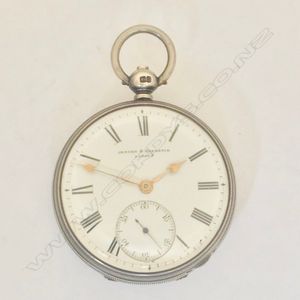Victorian Silver Lady's Pocket Watch by Jenner & Knewstub
Unusual Victorian silver lady's open face pocket watch by Jenner & Knewstub, 40 mm case hallmarked London 1879. Most unusual keyless winding/hand setting. Winding via small folding handle inside rear cover, hand setting by pressing pendant button and turning a knurled wheel in the band of the case at V. lever escapement. White enamel dial with Roman numerals, rail track minutes, subs seconds dial at VI.
You must be a subscriber, and be logged in to view price and dealer details.
Subscribe Now to view actual auction price for this item
When you subscribe, you have the option of setting the currency in which to display prices to $Au, $US, $NZ or Stg.
This item has been sold, and the description, image and price are for reference purposes only.
- Victorian Period - The Victorian period of furniture and decorative arts design covers the reign of Queen Victoria from 1837 to 1901. There was not one dominant style of furniture in the Victorian period. Designers used and modified many historical styles such as Gothic, Tudor, Elizabethan, English Rococo, Neoclassical and others, although use of some styles, such as English Rococo and Gothic tended to dominate the furniture manufacture of the period.
The Victorian period was preceded by the Regency and William IV periods, and followed by the Edwardian period, named for Edward VII (1841 ? 1910) who was King of the United Kingdom and the British Dominions and Emperor of India for the brief period from 1901 until his death in 1910. - Keyless Watch - A keyless watch is a type of pocket watch or wristwatch that does not require a separate winding key to wind or set the time. Instead, a keyless watch is wound and set by a small knob or button located on the side of the watch, called a crown.
Keyless watches were first introduced in the late 19th century and quickly became popular due to their convenience and ease of use. Prior to the development of keyless watches, pocket watches were typically wound and set using a small key that was inserted into a hole in the watch case. The key would be turned to wind the watch's mainspring, and then turned again to set the time.
With the introduction of the keyless watch, watchmakers were able to simplify the winding and setting process by eliminating the need for a separate key. Instead, the crown on the side of the watch could be pulled out to set the time, and then pushed back in to wind the watch's mainspring.
The keyless watch design has since become the standard for most modern watches, both pocket and wristwatches. In addition to being more convenient to use, keyless watches are also typically more reliable and accurate than earlier models that used winding keys. - Lever Escapement - A lever escapement is a type of escapement mechanism used in mechanical clocks and watches to regulate the timekeeping of the movement. It was invented by British clockmaker Thomas Mudge in the 18th century and is now widely used in modern mechanical timepieces.
The lever escapement consists of three main parts: the escape wheel, the pallet fork, and the lever. The escape wheel is a wheel with teeth that is driven by the clock or watch's main spring or weight. The pallet fork is a two-pronged component that is positioned so that it can engage with the teeth of the escape wheel, and the lever is a small, L-shaped component that is attached to the pallet fork.
When the escape wheel turns, one of its teeth pushes against one of the pallet fork's prongs, causing the fork to pivot. As the pallet fork pivots, it releases the tooth and engages with the next tooth on the opposite side of the escape wheel. At the same time, the lever, which is connected to the pallet fork, rocks back and forth, allowing the escape wheel to turn at a regulated rate.
The lever escapement is prized for its accuracy and reliability and is commonly used in high-end mechanical watches. It allows for precise timekeeping by ensuring that the movement of the watch or clock is regulated and consistent, and its compact size makes it an ideal choice for use in small, portable timepieces.
This item has been included into following indexes:
-
pocket watches, case type
- silver case 905
- silver, open face 204
- pocket watches, features - ladies 460
- watches - pendant 106
